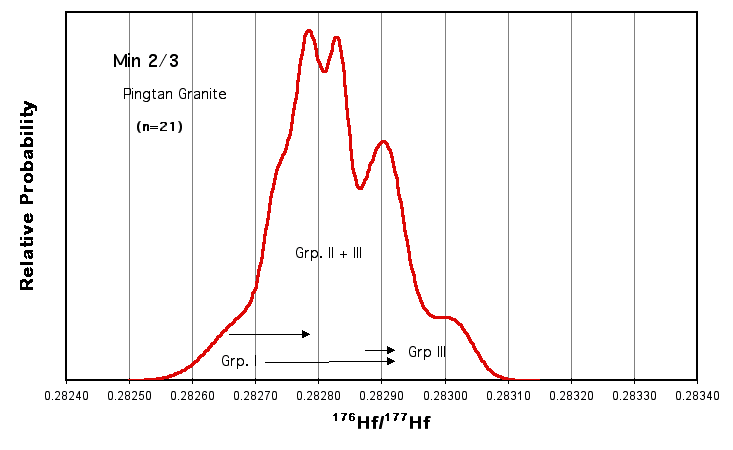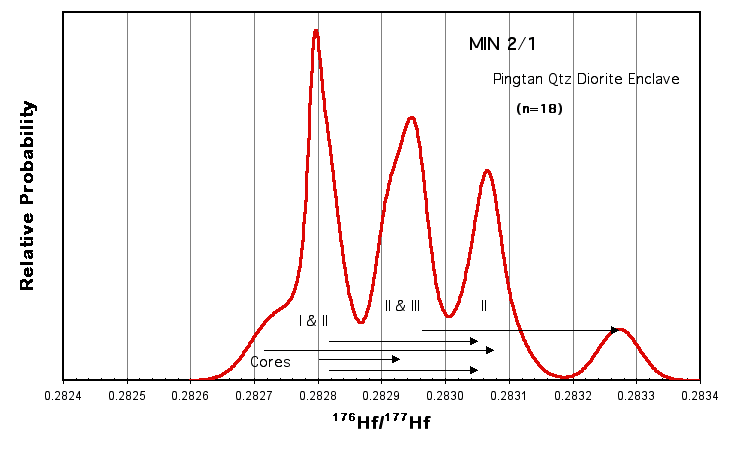W.L. Griffin1,2, X. Wang3, S.E. Jackson1, N.J. Pearson1, S.Y. O'Reilly1 and X. Xu3
1. GEMOC Macquarie
2. CSIRO Exploration and Mining
3. Dept. of Geology, Nanjing University
Introduction: The Pingtan complex in coastal Fujian Province,
SE China, includes a range of rock types ranging from granite through granodiorite
to gabbro, intruded ca 115 Ma ago as part of the major Yanshanian magmatic
event. Field relationships in the complex demonstrate extensive mingling
of mafic and felsic magmas, producing pillow-like enclaves, and formation
of at least some intermediate members of the suite through hybridisation.
All of the rock types have similar Sr (initial 87Sr/86Sr =0.7065) and Nd
(eNd = -1.5) isotopic compositions that suggest that both the felsic and
the mafic magmas represent contain a significant crustal component.
However, Nd model ages (TDM) are =1Ga, significantly younger than known
crust in the region (1.4-2.0 Ga), suggesting the presence of a juvenile
component as well. To investigate the processes of crust-mantle interaction,
and specifically the timing of any mixing of crustal and mantle components,
we have carried out a detailed study of the Hf isotope composition of the
Pingtan rocks, using LAM-MC-ICPMS techniques to analyse Hf isotopes in
individual zircon grains.
Zircons (?150x50 µm) were separated from (1) a granite,
(2) a granodiorite enclave (pillow) in the granite, (3) a quartz diorite
enclave adjacent to (2), (4) a granodiorite and a (5) a gabbro. The
zircons in each of these rocks show several growth stages, which can be
recognised by studies of external morpholgy and of internal morphology
revealed in BSE/CL images. In many examples unzoned or weakly zoned
cores, interpreted as representing pre-emplacement zircon growth, are overgrown
by 1-3 stages of oscillatorily zoned material, interpreted as post-emplacement.
Detailed studies of these zones by EMP (Hf, Y, U, Th) and LAM-ICPMS (REE,
U, Th, other trace elements) show that changes in internal morphology or
zoning style typically correlate with changes in trace-element patterns,
interpreted as reflecting changes in magma composition and/or physical
conditions. Some of these changes are in the direction predicted
by fractional crystallisation trends, while others appear to represent
sharp breaks. It is clear from these studies that the zircons have
acted as recorders of the compositional evolution of the magmas.
Analytical Methods: Hf isotope measurements were done using a
Merchantek LUV266 Nd:YAG ultraviolet laser probe, attached to a Nu Plasma
multi-collector ICPMS at GEMOC. Typical spot sizes were 30 microns;
most analyses were run at 4Hz repetition rate and 1-1.5 mJ/pulse, resulting
in total Hf signals of 1-3 x10-11 A and a typical internal precision on
176Hf/177Hf of ±0.00002-6 (2SE) on 1-2 minute ablations. Interferences
of 176Lu and 176Yb on 176Hf were corrected by monitoring 175Lu and 172Yb;
the accuracy and precision to which these overlaps can be corrected have
been demonstrated by repeated analysis of standard zircons (Griffin et
al., 1999; GCA, in press), and are comparable to the internal precision
given above.
Due to the small size of the grains, most analyses consisted
of a single ablation run of 1-3 minutes, drilling from the exposed inner
part of the grain through the rim below. The time-resolved data collection
routine of the Nu Plasma software commonly showed that distinct "stratigraphy"
in both Yb/Hf, Hf intensity and 176Hf/177Hf was intersected by the beam
during drilling, making it possible to select parts of the signal representing
major zones. The correlation of the ablated material with the zones identified
by the detailed BSE studies was done by comparison of the Hf intensity
and Yb/Hf ratio with the EMP/LAM data. In many cases this technique
made it possible to obtain analyses of zones thinner than the beam diameter,
because the drill rate (ca 0.5 µm/sec) allowed acquisition of reasonable
statistics for each zone. In some larger grains we were able to drill
two holes representing the central parts and a pyramidal tip, giving further
data on zoning. However, the largest number of analyses include large
portions of the grain, and probably represent mixtures of two or more growth
stages.
Results: The results are presented as cumulative curves of 176Hf/177Hf
, which take into account the analytical uncertainties on each analysis.

Figure 1. Distribution of Hf-isotope compositions in zircons from
granite Min 2/3.
I, II and III represent sequential growth stages, arrows show
zoning (core-rim)
in individual grains
(1) Granite (M2/3; Fig. 1): 21 analyses from 14 zircons
show a major peak of 176Hf/177Hf between 0.28275 and 0.28285, and a large
subsidiary peak at 0.28290. Individual core analyses have values
as low as 0.28265 and individual rims up to 0.2830. the largest
zoning in a single grain is from 0.28272 (core) to 0.28293 (rim).
(2) Granodiorite (M4): 14 zircons define a single major peak
at 176Hf/177Hf =0.28275-0.28280, skewed to higher values and with
a smaller subsidiary peak at 0.28290. Comparisons with morphology
indicates that the major peak represents the cores of grains and the rims
are represented by the higher values.
(3) Gabbro (M6): 14 zircons show a sharp peak between 0.28273
and 0.28283, with a small peak at 176Hf/177Hf = 0.28297. Limited
zoning indicates that pre-emplacement cores lie at the low end of the major
peak, and the post-emplacement overgrowths at the high end.
(4) Granodiorite enclave (M2/2): 19 zircons show a single
sharp peak between 176Hf/177Hf = 0.28275 and 0.28282, with a smaller
subsidiary at 0.2929-0.28295. Zoning indicates that cores lie in
the low end of the range (0.28270) and rims in the high end.

Figure 2. Distribution of Hf-isotope compositions in zircons from
the quartz diorite enclave.
I, II and III represent sequential growth stages, arrows show
zoning (core-rim)
in individual grains
(5) Quartz Diorite enclave (M2/1): This is the most complex sample (Fig. 2); 18 analyses from 12 zircons show three distinct peaks at 176Hf/177Hf = 0.28280, 0.28295, 0.28305, and a smaller peak near 0.28325, the highest value found. The zoning of individual grains, and comparison with the morphological and trace-element studies, suggest that the major peak at 0.28280 represents the earliest stages of growth (Stage I), and that these are overgrown by material with 176Hf/177Hf= 0.28305 (Stage II), which is in turn overgrown by Stage III zircon with intermediate 176Hf/177Hf= 0.28295. In one case zircon with this composition is overgrown by that with the highest 176Hf/177Hf recorded. This sample appears to record the interaction between at least two magmas (Stages I and II) with significantly different Hf-isotope compositions, which mixed to give one that crystallised the Stage III zircon. A final addition of still more juvenile material may have occurred at a later stage before all of the zircon crystallised.
Discussion: While the field relations suggest that the granodiorites
and quartz diorites were formed by mixing between the gabbro and the granite,
the zircon data suggest a much more complex picture. All samples
contain a major component defined by 176Hf/177Hf =0.2828±0.00005,
which appears in most of them to represent the earliest growth stage of
zircon (Stage I). The granodiorite and the gabbro have the simplest
patterns, consisting mainly of Stage I. These magmas have eHf =+4
and TDM model ages of 620 Ma, which give a minimum age for the source material;
they may represent the remelting of Proterozoic lower crust with low Lu/Hf
. The granite also contains an additional component with lower 176Hf/177Hf,
as well as major components corresponding to the Stage II and Stage III
(mixing) peaks of the quartz diorite enclave, and the granodiorite enclave
contains both Stage I and Stage III peaks. While further work will
be required to fully understand these patterns, it is clear that mixing
of magmas with disparate Hf-isotope compositions, reflecting derivation
from different sources, has taken place several times during the evolution
of the Pingtan complex, and that some of the individual magma types are
themselves the result of such mixing. The Stage II magmas are significantly
more juvenile (eHf = +12; TDM = 335 Ma) than those of Stage I , and several
zircons contain evidence of the addition of material with eHf as high as
+19, representing a very depleted mantle source at that time. The
repeated input of mantle-derived magmas probably has been important in
providing heat for the production of the granitic complexes, but the isotopic
data suggest that they also have contributed new material to the crust.
The use of zircon as a process recorder recovers information
on the evolution of magmas that is lost during the analysis of whole-rock
samples. The availability of rapid, low-cost in-situ microanalysis
of trace-element patterns and Hf-isotope compositions of zircons, coupled
with the detailed study of internal morphology, is about to bring major
advances in our understanding of magma genesis in crustal settings.
The same techniques can be applied to other minerals with appropriate parent-daughter
ratios and trace-element concentrations.

 GEMOC ARC National Key Centre
GEMOC ARC National Key Centre